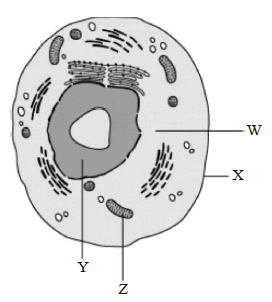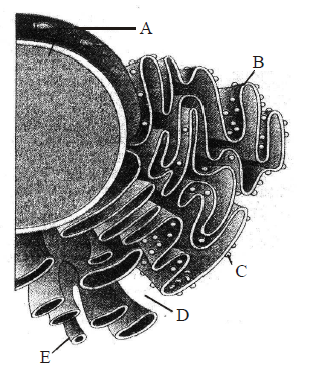Satellite means
terminal part of the chromosome beyond secondary constriction.
terminal part of the chromosome beyond primary constriction.
terminal part of chromosome beyond tertiary constriction.
none of the above
Correct Answer :
A. terminal part of the chromosome beyond secondary constriction.
Satellite is a small chromosomal segment separated from the main body of the chromosome by a secondary constriction. In humans it is usually associated with the short arm of an acrocentric chromosome. They play a vital role in the formation of the nucleolus after cell division. In humans, chromosomes number 13, 14, 15, 21 and 22 are examples of SAT (satelite) chromosomes.
Related Questions
Match column-I (cell organelle) with column-II membrane and select the correct option from the codes given below.
| Column-I | Column-II |
|---|---|
| A. Mitochondria | I. Without membrane |
| B. Lysosomes | II. Single membrane |
| C. Ribosomes | III. Double membrane |
A - I, B - II, C - III
A - III, B - I, C - II
A - III, B - II, C - I
A - II, B - III, C - I
Select the statements which are related to Schwann.
- He reported that cells have a thin outer layer which is today known as plasma membrane
- Cell wall is a unique character of the plant cell.
- Body of plants and animals are composed of cells and products of cells.
Only (i)
Only (iii)
(i) and (iii)
All of these
Which of the following is incorrect ?
Mycoplasma is the smallest cell (0.3 �).
Bacteria are 3 to 5 �m in size.
The largest cell is the egg of an ostrich.
Nerve cells are some of the smallest cells.
Protein synthesis in an animal cell occurs
on ribosomes present in cytoplasm as well as in mitochondria.
on ribosomes present in the nucleolus as well as in cytoplasm.
only on ribosomes attached to the nuclears envelope and endoplasmic reticulum.
only on the ribosomes present in cytosol.
The membrane of the erythrocytes has approximately ___% of proteins and ___% lipids.
42, 50
52, 40
50, 50
60, 40

Which cellular structure helps in transferring genetic information from one generation to another?
W
X
Y
Z
Which of the following statement is correct regarding vacuole?
It is membrane-bound and contains storage proteins and lipids.
It is membrane-bound and contains water and excretory substances.
It lacks membrane and contains air.
It lacks membrane and contains water and excretory substances.
Which of these is wrongly matched?
Chloroplasts Chlorophyll
Elaioplasts Starch
Chromoplasts Carotenoids
Amyloplasts Carbohydrates
Choose the incorrect match.
Nucleus RNA
Lysosome Protein synthesis
Mitochondria Respiration
Cytoskeleton Microtubules
Which of the following statements are correct ?
- In prokaryotic cells, a special membranous structure formed by the extension of the plasma membrane into the cell is known as polysome.
- The smooth endoplasmic reticulum is the major site for synthesis of glycoproteins.
- RuBisCO is the most abundant protein in the whole biosphere.
- Mitochondria, chloroplasts and peroxisomes are not considered as part of endomembrane system. Of the above statements
(iii) and (iv)
(i) and (ii)
(ii) and (iii)
(i) and (iv)
The main organelle involved in modification and routing of newly synthesized proteins to their destinations is
chloroplast
mitochondria
lysosome
endoplasmic reticulum
Plastids storing fat are called
Elaioplasts
Sphaerosomes
Aleuroplasts
Pyrenoids
Active transport differs from passive transport in that active transport
requires energy.
always requires input of ATP.
moves molecules against a concentration gradient.
both (a) and (c)
Centrifugation of a cell results in the rupture of the cell membrane and the contents compacting into a pellets in the bottom of the centrifuge tube. Bathing this pellet with a glucose solution yields metabolic activity including the production of ATP. One of the contents of this pellet is most likely which of the following?
Cytosol
Mitochondria
Lysosomes
Golgi bodies
Identify the components labelled as A, B, C, D and E in the diagram given below from the list (i) to (viii).

- Cristae of mitochondria
- Inner membrane of mitochondria
- Cytoplasm
- Smooth endoplasmic reticulum
- Rough endoplasmic reticulum
- Mitochondrial matrix
- Ribosome
- Nucleus
A - (viii), B - (v), C - (vii), D - (iii), E - (iv)
A - (i), B - (iv), C - (vii), D - (vi), E - (iii)
A - (vi), B - (v), C - (iv), D - (vii), E - (i)
A - (v), B - (i), C - (iii), D - (ii), E - (iv)
The best material for study of structure of cell membrane is
RBC of human
RBC of frog
cheek cell of human
liver cell of rat
Which of the following is not the function of cell wall?
- Provides shape to the cell.
- Protects the cell from mechanical damage and infection.
- Helps in cell to cell interaction.
- Provides barrier to undesirable macromolecules.
Only (i)
Only (iv)
Only (ii), (iii) and (iv)
None of the above
In which method of transport, plasma membrane does not require carrier molecule?
Active transport
Facilitated diffusion
Simple diffusion
Na+ K+ pump
In prokaryotes, chromatophores are
specialized granules responsible for colouration of cells
structures responsible for organizing the shape of the organism.
inclusion bodies lying free inside the cells for carrying out various metabolic activities.
internal membrane system which becomes extensive and complex in photosynthetic bacteria.
Match column-I with column-II and select the correct option.
| Column - I | Column - II |
|---|---|
| A. RER | I. Intracellular and extracellular digestion |
| B. Cell wall | II. Provide structural support to the cell |
| C. Flagella | III. Protein synthesis and secretion |
| D. Lysosomes | IV Responsible for cell movement |
A III, B II, C IV, D I
A II, B III, C IV, D I
A I, B III, C II, D IV
A IV, B II, C III, D I
Cell sap is a
living content of cytoplasm.
nonliving content of cytoplasm.
nonliving content of vacuole.
living content of vacuole.
Match column-I with column-II and choose the correct option.
| Column-I | Column-II |
|---|---|
| (Chromosome) | (Position of Centromere) |
| A. Metacentric | I. At the tip |
| B. Submetacentric | II. Almost near the tip |
| C. Acrocentric | III. At the middle |
| D. Telocentric | IV. Slightly away from the middle |
A III; B IV; C II; D I
A IV; B III; C II; D I
A I; B II; C III; D IV
A IV; B III; C I ; D II
Select the incorrect statement about prokaryotic ribosomes.
50S and 30S subunits unite to form 70S ribosomes.
Polysome/polyribosome consists of many ribosomes only.
Ribosome is the site of protein synthesis.
Polysome indicate the synthesis of identical poolypeptide in multiple copies.
Microtubules, motor proteins, and actin filaments are all part of the
mechanism of photosynthesis that occurs in chloroplasts.
rough ER in prokaryotic cells.
cytoskeleton of eukaryotic cells.
process that moves small molecules across cell membranes.
A component of cytoskeleton is
microtubule
bone
chitin
cartilage.
Which of the following statements is/are correct ?
- The endomembrane system includes plasma membrane, ER, Golgi complex, lysosomes and vacuoles.
- ER helps in the transport of substances, synthesis of proteins, lipoproteins and glycogen.
- Ribosomes are involved in protein synthesis.
- Mitochondria help in oxidative phosphorylation and generation of ATP.
(ii), (iii) & (iv)
(i) only
(ii) only
(iii) only
Who proposed the theory that Cells arise only from the pre-existing cells?
Mohl
Virchow
Haeckel
Brown
Nucleolus is
rounded structure found in cytoplasm near nucleus.
rounded structure inside nucleus and having rRNA.
rod-shaped structure in cytoplasm near the nucleus.
none of the above.
Which of the following statements are incorrect ?
- Plant cells have centrioles which are absent in almost all animal cells.
- Ribosomes are the site of protein synthesis.
- The middle lamella is a layer mainly of calcium carbonate which holds the different neighbouring cells together.
- In animal cell, steroidal hormones are synthesized by smooth endoplasmic reticulum. Of the above statements
(i) and (iii)
(iii) and (iv)
(ii) and (iv)
(i) and (iv)
Statement 1: Centrosomes and centrioles are related to each other.
Statement 2: Centrosome usually contains two cylindrical structures called centrioles.
Both statements -1 and statement - 2 are true and statement - 2 is the correct explanation of statement - 1.
Both statements -1 and statement - 2 are true but statement - 2 is not the correct explanation of statement - 1.
Statement -1 is true and statement - 2 is false.
Statement -1 is false and statement - 2 is true.
